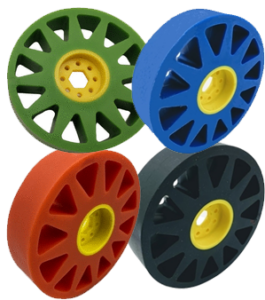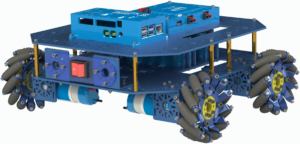Gearing Up for FRC CRESCENDO
This year's FIRST® Robotics Competition is here and the crescendo is building! CRESCENDOSM presented by Haas is an intriguing game. FRC teams are ready to pump up the volume, you can feel the excitement buzzing in the air! This article will provide a brief overview of FIRST and FRC, explore the intricacies of this year's game, and share robotics tools that can help teams hit the right notes in this competition.
What is FRC?
Let's begin by highlighting FIRST. This acronym stands for "For Inspiration and Recognition of Science and Technology." For thirty years, this amazing non-profit organization has been advancing STEM education and serving young people. FRC (FIRST Robotics Competition) is one of the programs they offer. Teams in this competition must design, build, and program a robot to compete in a challenge. All teams must begin with a standard set of parts and comply with a standard set of rules to compete. Teams are also responsible for developing their brand identity, creating community partnerships, and promoting robotics and STEM in their local communities. This competition is geared toward students between 14 and 18 years old. Students in grades 9 -12 can compete.
CRESCENDOSM 2024 Overview
This year's FRC challenge requires creative collaboration, strategy, and technical prowess. If you haven't already guessed from the title, this is a music-themed competition where teams are striving to compose the winning symphony of Coopertition® and robotics. The definition of Coopertition as explained by FIRST** is that "teams help and cooperate with each other, even as they compete. It's about learning from teammates, teaching others, collaborating with mentors, managing, and being managed. Coopertition embodies the spirit of competing while assisting and enabling others whenever possible." In the game, alliances must compete to score notes in three distinct field elements. However, the object of the game is not only to score points. Teams must also amplify speakers, harmonize, and get onstage to take the spotlight. The game has autonomous and teleoperated phases.
Game Summary
Here are some of the tasks that teams need to complete:
- Autonomous Mode: In this phase, teams start with a preloaded note. They have 15 seconds where the programmed robot can play notes into the speaker or amp. They can also collect or play additional notes.
- Teleoperation Mode: Here drivers have two minutes and 15 seconds to control their robots. They will collect notes from their human players and the base and take them to their speaker or amp to play them. If they insert two notes into their amp, their human player can amplify the speaker for ten seconds by hitting a button. Notes played on an amplified speaker earn more points.
- Getting Onstage: In the last 20 seconds of the game, robots must get onstage by hanging from a chain and then scoring a note using the flap on the trap. Harmony is rewarded, as teams earn more points when they get onstage using the same chain. If the human player can score a note on the microphone corresponding to the chain this spotlights the robots and earns more points.
- Scoring Ranking Points: Ranking points are awarded based on the results of a match. A tie is worth 1 ranking point, and a win is worth 2 points. MELODY and ENSEMBLE ranking points can also be awarded during the match. To earn the MELODY point, they must score at least 18 (15 if Coopertition bonus) notes in the amp & speaker. To earn the ENSEMBLE point, they must score at least 10 STAGE points and have at least 2 onstage robots for the match.
- Coopertition® Points: Cooperation is key to this competition. If in the first 45 seconds of the teleoperation period, every team plays a note by hitting their competition button, everyone benefits as all the teams will collect a competition point. These points are used to determine team rankings. It also reduces the number of played notes required to earn a bonus ranking point.
CRESCENDO Insights
CRESCENDO is an interesting game. The fact that there is now a singular scoring station (the speaker) during the main teleoperated phase means that to succeed, teams must coordinate with each other to earn as many challenge points as possible as well as ranking points. Teamwork is dream work as they say because teams must collaborate, strategize, and cooperate to earn Coopertition bonus points. Given the volume of notes needed to score a Melody ranking point, scoring during the final 20 seconds of teleoperation mode, as well as scoring a Coopertition point becomes even more paramount when it comes to climbing rankings. This is going to make this season very interesting. We look forward to seeing the strategies that teams and alliances implement to succeed. Watch this video to learn more.
The Tools to Succeed
Having the right robotics components, such as compliant wheels, is crucial to success in robotics competitions such as FRC. Studica Robotics is a comprehensive robotics building platform with everything you need to build, learn, and compete. We offer a variety of structure and motion components, electronics, hardware, and building kits. We offer a wide variety of robot wheels including compliant wheels.
Compliant Wheels
For competitions, compliant wheels are ideal for intake, launcher systems, and conveyors in a robot design. The harder wheels are better for flexible, more malleable materials. Softer wheels are better suited to more rigid materials due to their flexibility. We offer a wide variety of compliant wheels (also referred to as flex wheels) that are made from a TPU Polyurethane with different degrees of hardness and flexibility. There are 100mm and 50mm compliant wheels available in various durometer hardness levels of 35A, 40A, 50A, and 60A. These wheels provide durable, reduced friction performance to launch notes efficiently and precisely in this year’s FRC competition. The hole pattern on the wheels provides flexibility because it allows users to use different hubs for different shaft sizes and types in a build to fit a team's needs. Shop Robot Wheels.
Training Robots
Studica Robotics also offers a robotics competition training kit that is geared to helping teams prepare to compete. The VMX FRC-compatible Training Bot is designed to be a smaller, less expensive robot. Robots for FRC competitions can be large and expensive. This robotics kit allows you to have more students involved in hands-on training. With robotics teams, typically only a few team members have the opportunity to work directly on the team's main competition robot. The FRC Trainer addresses this issue by offering a cost-effective tool to give more students a hands-on opportunity to acquire the skills needed to design and program for robotics competitions.
In conclusion, we are thrilled that the FIRST Robotics Competition CRESCENDO is underway! This innovative competition brings together challenging robotics tasks and focuses on key skills such as collaboration, cooperation, communication, and strategy. We look forward to seeing how teams and alliances will navigate this game. Let's go!
Sources: * https://www.firstinspires.org/ **https://www.firstinspires.org/about#:~:text=At%20FIRST%2C%20Coopertition%20means%20that,and%20enabling%20others%20whenever%20possible.




